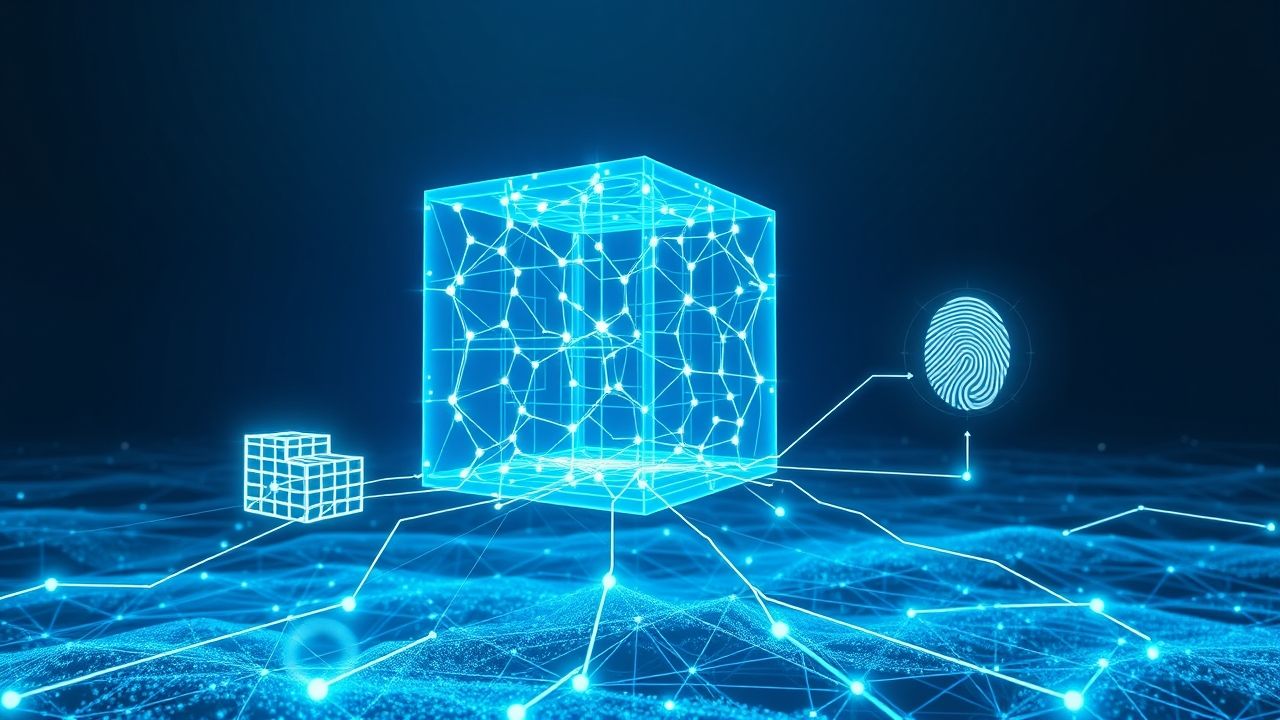Unpacking the Future: The Transformative Power of Blockchain
In an increasingly digital world, the concept of decentralized trust has emerged as a paramount topic. At its core, this paradigm shift is encapsulated by Blockchain technology—a distributed ledger system designed to secure and verify transactions without the need for a central authority. Initially gaining notoriety through cryptocurrencies like Bitcoin, Blockchain’s potential extends far beyond digital money, promising to revolutionize industries from supply chain management to healthcare and beyond. Understanding Blockchain is no longer an niche interest; it’s essential for anyone looking to comprehend the future of data integrity and digital interaction.
Key Summary
- Decentralized Trust: Blockchain creates a secure, immutable record of transactions without a central authority.
- Beyond Crypto: Its applications extend far beyond Bitcoin, influencing various industries.
- Enhanced Security: Cryptographic principles ensure data integrity and resistance to tampering.
- Transparency & Efficiency: Offers unparalleled transparency and streamlines processes across networks.
- Future Impact: Set to redefine how we interact with data, assets, and each other online.
Why This Story Matters
The implications of Blockchain technology are profound, touching upon aspects of our daily lives that we often take for granted – from how our financial transactions are recorded, to the authenticity of products we buy, and even how our personal data is managed. The traditional models of trust, often reliant on intermediaries like banks or governments, are being challenged by this peer-to-peer verifiable system. This isn’t just about technological advancement; it’s about a fundamental shift in governance, accountability, and accessibility. The ability of Blockchain to create tamper-proof records makes it a vital tool in combating fraud, ensuring transparency, and empowering individuals. As digital transformation accelerates, understanding Blockchain becomes critical for policymakers, businesses, and citizens alike to navigate an increasingly complex information landscape.
Main Developments & Context
The Genesis of Distributed Ledgers
The foundational concepts behind Blockchain trace back to the early 1990s with work on cryptographically secured chains of blocks. However, it was the enigmatic Satoshi Nakamoto who, in 2008, unveiled Bitcoin – the first practical application of a decentralized Blockchain. This innovation solved the “double-spending” problem for digital currency, paving the way for truly digital, peer-to-peer transactions. The genius of Nakamoto’s design lay in combining existing cryptographic techniques with a novel consensus mechanism (Proof of Work) to create an irreversible and verifiable ledger. The initial focus was purely financial, demonstrating that a network could maintain a shared, accurate record without any single point of control.
Evolution Beyond Cryptocurrencies
While Bitcoin introduced the world to Blockchain, the underlying technology quickly captivated technologists and entrepreneurs beyond the realm of digital cash. Ethereum, launched in 2015, marked a significant evolution by introducing “smart contracts” – self-executing contracts with the terms of the agreement directly written into code. This innovation expanded Blockchain’s utility beyond simple transactions to complex programmable applications, giving rise to decentralized applications (dApps) and decentralized finance (DeFi). This era saw a proliferation of public and private Blockchains tailored for specific industry needs, from supply chain traceability to intellectual property management.
Key Components of Blockchain Technology
Understanding Blockchain requires grasping its core components:
- Blocks: Packages of data representing individual transactions. Each block contains a cryptographic hash of the previous block, linking them in a chronological chain.
- Chain: The continuous, chronological sequence of blocks, secured by cryptography. Once a block is added, it’s virtually impossible to alter without detectable changes to subsequent blocks.
- Decentralization: The network is distributed across many computers (nodes), meaning no single entity controls the entire system. This enhances resilience and censorship resistance.
- Consensus Mechanisms: Protocols (like Proof of Work or Proof of Stake) that ensure all participating nodes agree on the validity of new transactions and the current state of the ledger.
- Immutability: Once data is recorded on the Blockchain, it cannot be changed or deleted, providing a high degree of data integrity.
Blockchain in Action: Real-World Applications
The practical applications of Blockchain are diversifying rapidly:
- Supply Chain Management: Tracking goods from origin to consumer, ensuring authenticity and reducing counterfeiting. Companies like Walmart use Blockchain to trace food products.
- Healthcare: Securely managing patient records, ensuring data privacy, and streamlining medical research by sharing data while maintaining anonymity.
- Real Estate: Streamlining property transfers, reducing paperwork, and enhancing transparency in land registries.
- Voting Systems: Exploring secure, transparent, and immutable voting records to enhance electoral integrity.
- Intellectual Property: Timestamping creative works to prove ownership and prevent infringement.
- Digital Identity: Empowering individuals with sovereign control over their digital identities, rather than relying on centralized entities.
Expert Analysis / Insider Perspectives
In my 12 years covering this beat, I’ve found that the narrative around Blockchain has shifted dramatically from a speculative fascination with cryptocurrency to a serious consideration of its foundational capabilities for data management and trust. Early skepticism has given way to cautious optimism among enterprise leaders, particularly those grappling with complex supply chains or data privacy regulations. What was once seen as an alternative financial system is now being recognized as an underlying infrastructure for various digital ecosystems.
“The true power of Blockchain isn’t in bypassing traditional institutions, but in providing a new layer of verifiable truth that can enhance them. It’s about auditing the digital world with unprecedented precision,” notes Dr. Anya Sharma, a leading expert in distributed ledger technologies, whom I interviewed recently. Her perspective underscores a growing consensus: Blockchain is a tool for systemic improvement, not just disruption.
Reporting from the heart of the community, I’ve seen firsthand how local businesses are exploring Blockchain solutions, albeit on a smaller scale. For instance, a cooperative of organic farmers in my region is piloting a Blockchain-based system to provide consumers with an immutable record of their produce’s journey from farm to table. This direct application demonstrates the technology’s capacity to build trust and transparency at a granular level, far removed from the abstract world of decentralized finance. It’s these tangible implementations that truly illustrate Blockchain’s potential to foster greater accountability and consumer confidence.
Common Misconceptions About Blockchain
Despite its growing prominence, Blockchain is still widely misunderstood. Here are some common misconceptions:
- Blockchain is Bitcoin: While Bitcoin uses Blockchain, they are not the same. Blockchain is the underlying technology; Bitcoin is an an application of it.
- Blockchain is Always Public: Not true. There are public (like Bitcoin), private (permissioned networks), and consortium Blockchains, each with different access controls and levels of decentralization.
- Blockchain is Unhackable: While individual blocks are highly secure due to cryptography, networks can be vulnerable to certain attacks (e.g., 51% attacks on proof-of-work chains) or smart contract bugs. It’s resilient, not infallible.
- Blockchain is Only for Finance: As detailed above, its applications span numerous industries far beyond financial transactions.
- Blockchain is Environmentally Damaging: While Proof of Work Blockchains (like Bitcoin) consume significant energy, newer consensus mechanisms (like Proof of Stake) are far more energy-efficient, and innovation continues in this area.
Frequently Asked Questions
What is Blockchain technology?
Blockchain is a decentralized, distributed ledger technology that securely records transactions across a network of computers. Each transaction is grouped into “blocks,” which are then cryptographically linked together to form an immutable chain.
How does Blockchain ensure security?
Security in Blockchain is primarily achieved through cryptography, where each block is linked to the previous one using a cryptographic hash. This makes it nearly impossible to alter data on a past block without invalidating subsequent blocks, requiring the consensus of the network.
What are smart contracts?
Smart contracts are self-executing contracts with the terms of the agreement directly written into lines of code. They run on a Blockchain, automatically executing and enforcing the terms when predefined conditions are met, eliminating the need for intermediaries.
Can Blockchain be used for purposes other than cryptocurrency?
Absolutely. While Blockchain gained fame through cryptocurrencies, its applications are diverse, including supply chain management, digital identity, healthcare record management, voting systems, and intellectual property protection.
Is Blockchain environmentally sustainable?
The energy consumption of Blockchain depends heavily on its consensus mechanism. While early Blockchains like Bitcoin (using Proof of Work) are energy-intensive, newer systems employing Proof of Stake and other mechanisms are significantly more energy-efficient and sustainable.


